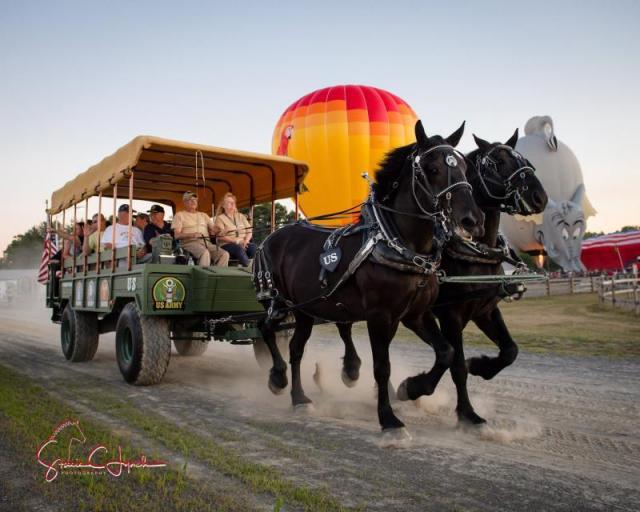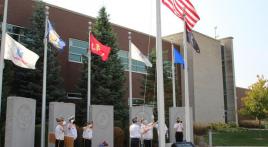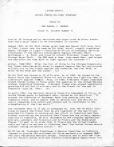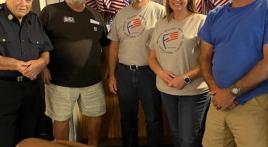Frank Castella is a small business owner, farmer, and patriot. His passions are the Percheron horses he raises, antique cars, family and veterans.
Though Frank never served in the military, he holds the honorable service of his father-in-law in great respect. Durward E. "Curly" Hutchings was a ball turret gunner on the B-17 Flying Fortress known as "Katie's Boys" during WW II, 100th Bomb Group, 351st Bomb Squadron. During a bombing raid on Berlin, March 8, 1944, the plane was crippled by enemy fighters but continued on to bomb its intended target at Erkner, after which the crew bailed out and the plane crashed. Durward was captured by German farmers and turned over to the German Army. He was held prisoner for over a year before his release on April 30, 1945, at which time he weighed less than 90 pounds. He later received the Air Medal with two Oak Leaf Clusters, the Purple Heart, the Good Conduct Medal and the Presidential Medal with Oak Leaf Clusters. He married Ruth DuBois on July 15, 1945 and was discharged as a staff sergeant on October 26, 1945. The couple had three daughters, the first of which was Karen, Frank's wife
In honor of Durwood and all veterans, Frank decided to build a wagon that would be accessible for wounded and physically handicapped veterans.
"We (my daughter, Stacie, and son-in-law, Brian) did a Memorial Day parade with my hitch wagon a while back," Frank recalls. "The parade organizers asked me to carry the local politicians on the wagon. I said 'bull–if we do the parade, it will be with some of our veterans on board, or no deal.' Well, when we did the parade, the vets had a problem climbing the ladder to get on the hitch wagon. As a matter of fact, we had to call on the local rescue crew to help. That’s when I first began to think about a purpose vehicle. one with a wheelchair lift, special stairs and hand rails. 'I really did not have a firm plan at that point,'"he continued.
He decided to build a wagon that would be accessible for wounded and physically handicapped veterans. His idea was to make a bold statement, while being able to accommodate disabled veterans. He envisioned a wagon that would have a bold appearance and yet have an antique look. Specifically, he wanted to strive for the resemblance of a WW1 Troop carrier.
But Frank obsessed over the idea, as his family will corroborate. "Searching the web for a frame and wheels, looking at historical support wagons of the past, I began to think about a 'hybrid' tribute wagon, using design aspects of early military support vehicles that I could incorporate into a 21st century vehicle," he recalls. "My thoughts began to lean toward something BOLD, and BIG and HEAVY, needing real horsepower to pull. I went to a military surplus auction web site and found a running gear that had four flotation tires on it and a heavy frame, just the correct length to build on."
Frank's find then resulted in his successful bid for it, of only $1. Now that was the good news. The bad news was that the running gear was located on a military base in Alaska! For a touch of perspective, there are over 4,000 driving miles between the Empire State and the last frontier. But not one to be easily discouraged or dissuaded, Frank said to himself, "'Self, how the heck are you going to get this 5,000-pound behemoth home?' I contacted a supply sergeant at the base [in Alaska] and told him my plans."
Through his considerable powers of persuasion, Frank gained the man's help by making a sizable donation to an organization "dear to the supply sergeant's heart." The supply sergeant arranged for transportation of the running gear to a military base in California. From there, it was transported to the East Coast, where Frank contracted with a private carrier to bring it to his shop in New York. In terms of logistics, the insurmountable had been accomplished.
He and some like-minded friends built a unique vehicle that includes four-wheel brakes with a brake pedal for the rear to be used when driving and the other for the front. While loading passengers, all four brakes can be locked with a hydraulic line lock. An electric wheel chair lift was installed on the rear with a safety ramp. On the driver’s side are folding steps and folding hand rails right and left of the steps. The roof line is that of a WW I army ambulance or troop carrier. The driver’s area has similar lines for the foot perch area, taken from an earlier type military vehicle from around the 1850s Indian War era. Each side of the vehicle has porcelain signs representing the five branches of U.S. military service. On the rear Frank has the American flag and the POW/MIA flag.
NOW WHAT? This wasn't going to be any kind of undertaking for a novice. Fortunately, we aren't talking about one. Frank is an accomplished craftsman. When I inquired what that meant exactly, he replied, "I've built a number of horse-drawn vehicles in the past. I would say my hitch wagon is my crowning lifetime achievement. Being a car restorer as a hobby certainly helps with skills in body work, electrical welding, mechanical, etc. At this point I would say I grew up in a loving family, without much in the way of money, therefore I learned early in life if you want something, you need to work for it. I have been building things all my adult life–a house, barns, cars, trucks, a hitch wagon. I remember when I wanted to start showing our Percheron horses, I went to the local auto junk yard and found a suitable truck, purchased it and had it towed out to my farm. My three girls - Stacie, Kim and Carrie – saw the tow truck coming down our driveway, I can still hear them yelling, 'Ma come quick, you won’t believe what he bought now. There’s a guy towing in a junk truck!'“
The concept for the vehicle was something that had been rolling around in Frank's head since carrying the veterans in that Memorial Day parade. He knew what needed to be included, he just wasn't sure what it would look like. "I did some rough sketches of different ideas, incorporating a wheel chair lift and stairs with hand rails," he recalls. "Since art is not one of my strong points, I had an artist that was working for me at the time put together the concept drawing. All I heard from people close to me is 'that’s insane; it can’t be done; it’s too big; it’s too heavy; you’ll never pull it with horses.' I had already figured in my mind four horses would be used because that’s what the military did prior to self-powered vehicles. The Army used mostly mules, however, we would use draft horse power. I knew in my heart that draft power would do the job without difficulty."
Frank's acquisition had been used as a plane deicing trailer, involving a tank and boom. What this translates to is the fact that it carried a lot of "extra parts" that needed to be removed. The chassis was then reconditioned and repainted in a befitting olive drab. Frank started to assemble the frame and some of the parts. It was 2011 and Frank did much of the work (and legwork) himself, including fabricating all of the metal fittings for the wagon, and for the seats. But he is quick to point out that like raising a child, the project required a village. He received help with the welding from John "Boz" Pultz, legendary chief fabricator for the Dyson Racing Team. Others that assisted with the construction included local fireman Jim Lieberman; veteran Air Force mechanic Matt Swanson, who offered up his heated shop for the work during winters; Gary Veeder, retired local pharmacist who tackled some of the woodworking; Bruce Anderson, donated canvas and finished the bows; Guy Webb, a neighbor, assisted with the canvas; and Lenny Miller, wood working. Many more contributed both financially and physically, but this was Frank's "main crew." The bulk of the Warrior Wagon's "major construction" took place during the winter of 2013-14.
With so many different components involved, from lighting, to a P.A. system, to the decorations, to hydraulic lifts and brakes, I was curious what ended up being the biggest challenge. Frank's answer: the seating. "Normally, a vehicle of this type would have bench seats on each side," he says. "That was not a suitable option. After thinking about this for months while the construction progressed on the frame, it came to me that the seating on a commuter air-line was about the same width as the Warrior Wagon. Seats could be removed as needed for wheelchairs. I purchased a spring seat from a commercial supplier for the driver and modified it to fit over the wheel wells. Then I copied the basic design of the seat tops and designed the bottoms to fit into E track tie-down hardware, so the seats can be adjusted or removed as necessary. [I made the seats] two wide on the near side, and one person wide on the off side, leaving a 24” aisle in the middle. I built eight rear seats, all equipped with mounting posts, fitting into E track." Frank then tested the rig with the help of a close friend who is wheelchair-bound. Reminiscent of a WW I Army ambulance, a top frame consisting of bent ash bows was constructed for the roof. Witmer's Coach Shop in New Holland, Pennsylvania, handled the wood-bending, while Frank created the metal fittings for them. The Warrior Wagon was definitely taking shape.
When Frank priced out the canvas top for the rig at local covering companies as well as an Amish outfit in Pennsylvania, he received quotes ranging from $2,500 to $3,500! "That’s when I decided to make the top myself," he states. "I did hear from someone close to me, 'You can’t make that top.' My response was, 'Just watch me.' All it takes is determination. Bruce Anderson got me the canvas and I began to call all my friends who might have contacts for a commercial sewing machine." Among them was 96-year-old Nick Decutis, a WW II veteran.
Frank recalls explaining his grand scheme on the phone, but Decutis still refused to loan out his antique (and well-used) Singer sewing machine. He insisted on coming out to the farm to see the project himself. "Well, when he arrived and I showed him the wagon," says Frank, "He looked at me and said, 'Well Kid, guess you’re going to get some lessons on using a sewing machine.'" So Frank "interned" at Decutis' place, tediously hauling the canvas back home after each session (which were short since Nick could only work a few hours at a time). Frank would put in hand stitches to hold each piece together prior to each sewing session."
Little by little and day by day, the Warrior Wagon took form. Weighing in at around 7,000 lbs. and measuring 93" wide, 9'9" tall and 22' long, this work of art is adorned with the seals of the various branches of the United States military, displayed in the proper order that each branch was founded. The MIA plaque is also displayed, and both the POW/MIA and the American flags rest in staffs located on the back of the vehicle. Two on-board 24-volt batteries provide the electrical power needed for the hydraulic wheelchair lift (complete with a safety ramp) at the rear, the on-board P.A. system including eight speakers and a marine radio (built into a surplus rocket can) all facilitated by over 500 feet of wiring. Folding steps and hand rails round out the amenities, making for an extremely unique and impressive sight.
READY OR NOT
The debuting of Frank's Warrior Wagon was scheduled for the World Percheron Congress held in Springfield MA. in October of 2014. Finishing touches on the canvas top, more electrical work, etc. still needed to be completed, but for all intents and purposes, it was ready for action.
Appearing in the opening ceremonies each evening of the event, Frank was able to fill it with veterans, including some who were involved in the Congress, such as Dave Schubert, announcer for the farm team competitions.
As WPC volunteer Tory MacDonald stated, "To be able to help make the opening ceremonies not only a tribute to our breed, but also to our military, I just am stumbling for words. I cried every night during these ceremonies and I realize that the entire arena was on their feet and wiping tears as well. It was truly an honor to be involved."
Steffen Dittmar, who came from Germany to attend the WPC, admitted that the "honoring of the veterans has played a huge role in my enthusiasm [for the event]."
Of the nearly 80 people who Frank hauled in the Warrior Wagon during the Congress, one, in particular stands out. "For me," he admits, "it was Lisa Menkins Estes. She lost her brother in the October 23, 1983 attack, when suicide bombers drove a truck into the U.S. Marine barracks in Beirut, Lebanon, killing 241 sleeping American servicemen. It was the largest surprise attack on Americans since Pearl Harbor, and remained so until September 11, 2001. Lisa drove our lead horse, Castles Diesel, in several ladies cart classes, back in the 1980s. It was truly an honor to have her on the Warrior Wagon."
The Congress was a huge success, due in no small part to this humble jack-of-all-trades from New York. "My hope is that our vets–past and present–will realize there are many people in the U.S.A. that appreciate what they do and are indebted for the sacrifices they make to keep us safe," he concludes. "This is just a small thank you from us, the working people, who make up this great country. My parents were immigrants to this country and [they] loved the opportunity to become citizens."
Since the debuting in the fall of 2014 Frank and the Warrior Wagon have traveled throughout Southeastern New York, Connecticut, New Jersey and Pennsylvania to participate in parades and veteran's ceremonies. He's also spent a couple of years at the Dutchess County Fair for six days each year. The fair is the second largest county fair in New York state. The logistics of transporting four-2000 lb. horses, harnesses, food, temporary stalls, a travel trailer for sleeping and of course the Warrior Wagon is a huge commitment in expense and time. Each day of the fair Frank and his crew would harness the horses, hitch them to the Warrior Wagon and take veterans on a ride around the fair grounds. They would stop part way through the ride for the playing of the National Anthem and the introduction of each of the veterans on the wagon.
"It's never too late to provide a hero's welcome home for war veterans, to show our respect and our gratitude. Through imagination, commitment and, above all, passion, the impossible became a reality, and affected countless people at a draft horse show (of all things) in ways never before imagined. Frank Castella did more than honor American veterans of war; he demonstrated America's "can-do" attitude for every-one around him.





